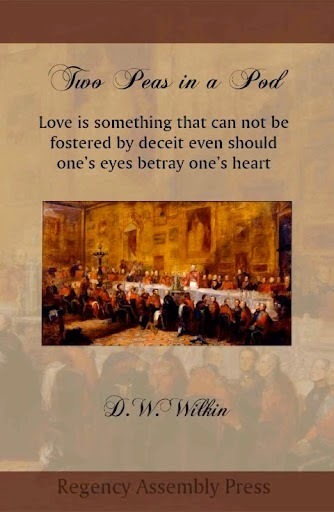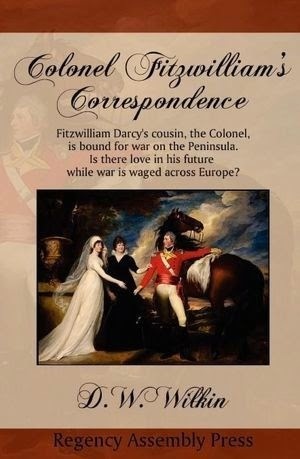D.W. Wilkin's Blog, page 155
February 7, 2015
Regency Personalities Series-Elizabeth Craven
Regency Personalities Series
In my attempts to provide us with the details of the Regency, today I continue with one of the��many period notables.
Elizabeth Craven Baroness Craven Margarine of Anspach
17 December 1750 ��� 13 January 1828
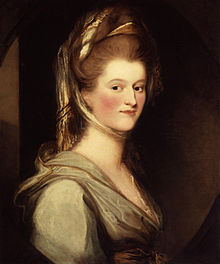
Elizabeth Craven
Elizabeth Craven, Princess Berkeley (though often styled “Margravine of Brandenburg-Ansbach”), previously “Lady Craven” of Hamstead Marshall, was an author, playwright, traveller, and socialite, perhaps best known for her travelogues. She was the third child of the 4th Earl of Berkeley, born near Trafalgar Square in the English City of Westminster
Early in her literary career she wrote a number of light farces, pantomimes, and fables, many of which were performed in London to no great acclaim. She knew Samuel Johnson and James Boswell, and became a close friend of Horace Walpole, who published her early works which, with later efforts, include:
The Sleep-Walker (trans. of Pont de Vile’s comedy La somnambule, 1778)
Modern Anecdotes of the Ancient Family of the Kinkvervankotsdarsprakengotchderns (satire, 1779)
The Miniature Picture (play, 1781)
A Journey through the Crimea to Constantinople (travel writing, 1789)
The Georgian Princess (produced 1798; published 1799). Ed. with an introduction by John Franceschina. British Women Playwrights around 1800. 15 January 2001.
Letters from the Right Honorable Lady Craven, to his serene highness the margrave of Anspach, during her travels through France, Germany, and Russia in 1785 and 1786 (travel writing, 1814)
Memoirs (1826)
Very few of her musical compositions survive:
O Mistress Mine (musical arrangement, about 1875)
The Princess of Georgia (opera, 1799)
Her life was full of scandal: after thirteen years of marriage, seven children, and affairs reported on both sides, she and her first husband, William Craven, 6th Baron Craven, (married since 30 May 1767), parted permanently in 1780. Thereafter she lived in France and travelled extensively on the Continent.
For a number of years she maintained a romantic relationship with Charles Alexander, Margrave of Brandenburg-Ansbach. His wife since 1754, Princess Friederike of Saxe-Coburg-Saalfeld, died in Germany on 18 February 1791, and Lady Craven’s husband died in Lausanne on 26 September 1791. The couple then married in Lisbon on 30 October 1791 and settled in England. While the Margravine was snubbed by ladies mindful of their reputations, as well as by her latest husband’s cousin, King George III himself, and as well as by Queen Marie-Antoinette when she visited France, the couple lived a full and opulent life in Hammersmith, London, and Benham Park at Speen in Berkshire.
Nonetheless, Elizabeth was never legally entitled to share her husband’s German rank and title: on 20 February 1801, she was granted the morganatic title of “Princess (F��rstin) Berkeley” by the last Holy Roman Emperor, Francis II. In fact, Christian Frederick, being the last of his cadet branch of the House of Hohenzollern, and childless, had exchanged his hereditary birthright to the appanages of Ansbach and Bayreuth for an annuity of 300,000 guilders from his pater familias, King Frederick William II of Prussia, a month after his second marriage. In England, however, the couple were usually known as the “Margrave and Margravine of Brandenburg-Ansbach”.
After the Margrave’s death at Benham Park in 1806, Elizabeth moved back to the Continent, to Naples, where she died at Craven Villa in Posillipo and was buried in 1828 in the English Cemetery. Her links with the Hammersmith area are commemorated in the name of two roads in the area ��� Margravine Gardens and Margravine Road.

February 6, 2015
Regency Personalities Series-Francis Osborne 5th Duke of Leeds
Regency Personalities Series
In my attempts to provide us with the details of the Regency, today I continue with one of the��many period notables.
Francis Osborne 5th Duke of Leeds
29 January 1751 ��� 31 January 1799
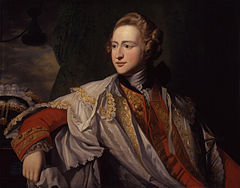
Francis Osborne
Francis Osborne 5th Duke of Leeds was the son of Thomas Osborne, 4th Duke of Leeds, by his wife Lady Mary, daughter of Francis Godolphin, 2nd Earl of Godolphin, and Henrietta Godolphin, 2nd Duchess of Marlborough. He was educated at Westminster School and at Christ Church, Oxford.
Leeds was a Member of Parliament for Eye in 1774 and for Helston from 1774 to 1775; in 1776 having received a writ of acceleration as Baron Osborne, he entered the House of Lords, and in 1777 Lord Chamberlain of the Queen’s Household. In the House of Lords he was prominent as a determined foe of the prime minister, Lord North, who, after he had resigned his position as chamberlain, deprived him of the office of Lord Lieutenant of the East Riding of Yorkshire in 1780. He regained this, however, two years later.
Early in 1783 Leeds was selected as ambassador to France, but he did not take up this appointment, becoming instead Secretary of State for Foreign Affairs under William Pitt the Younger in December of the same year. As secretary he was little more than a cipher: although they were friends of long-standing, Pitt developed a poor opinion of Leeds’ judgement and frequently had to restrain his bellicose instincts. The abandonment of his anti-Russian policy was the final blow and he left office in April 1791. He had done nothing to foster good relations with the newly independent United States of America: both John Adams and Thomas Jefferson complained of his obstructive attitude and ” aversion to having anything to do with us “. Subsequently he took little part in politics: in 1792, hearing rumours that a new coalition might be formed, he unwisely offered himself as its head and met with a firm rebuff from both Pitt and the King.
Leeds married firstly in 1773 Lady Amelia Darcy, daughter of Robert Darcy, 4th Earl of Holderness on 29 November 1773. Lady Amelia became Baroness Darcy de Knayth and Baroness Conyers in her own right in 1778. They were divorced in 1779. Their marriage produced three children:
George William Frederick Osborne, Marquess of Carmarthen (21 July 1775 ��� 10 July 1838), later 6th Duke of Leeds; married Lady Charlotte Townshend, daughter of the 1st Marquess Townshend.
Lord Francis Osborne (18 October 1777 ��� 15 February 1850), later 1st Baron Godolphin; married The Hon. Elizabeth Eden, third daughter of the 1st Baron Auckland.
Lady Mary Henrietta Juliana Osborne (1776-1862); married Thomas Pelham, 2nd Earl of Chichester.
He married secondly Catherine, daughter of Thomas Anguish, in 1788 and had two more children:
Lord Sidney Godolphin Osborne (1789-1861); unmarried.
Lady Catherine Anne Sarah Osborne (1791-1878); married Major John Whyte-Melville on 1 June 1819 and had issue. .
Leeds died in London in January 1799, aged 48, and was succeeded in the dukedom by his eldest son from his first marriage, George Osborne, 6th Duke of Leeds. His second son from his first marriage, Lord Francis Osborne, was created Baron Godolphin in 1832. The dowager Duchess of Leeds died in October 1837, aged 73.

Two Peas in A Pod, A Regency Romance
Two Peas in a Pod has now passed the exclusivity to Amazon test and is available in wider release, electronically (digitally) for other readers now. We sold a few copies on Amazon but nothing to warrant an exclusivity period. Amazon is too big and too full of itself.
Two Peas in a Pod is still available as a Trade paperback click here to order Regency Assembly Press.
$3.99 for an electronic copy. The Trade Paperback, due to publishing costs and the cut that Amazon takes continue to see a Trade Paperback costing $15.99 (The much hyped royalties that we writers are supposed to get is nowhere near what the news reports say. Most of that price is taken by Amazon.)
iBookstore (These are my books
and still at Amazon
Here is a picture, which of course you can click on to go fetch the book:
Love is something that can not be fostered by deceit even should one���s eyes betray one���s heart.
Two brothers that are so close in appearance that only a handful have ever been able to tell them apart. The Earl of Kent, Percival Francis Michael Coldwell is only older than his brother, Peregrine Maxim Frederick Coldwell by 17 minutes. They may have looked as each other, but that masked how they were truthfully quite opposite to one another.
For Percy, his personality was one that he was quite comfortable with and more than happy to let Perry be of a serious nature. At least until he met Veronica Hamilton, the daughter of Baron Hamilton of Leith. She was only interested in a man who was serious.
Once more, Peregrine is obliged to help his older brother by taking his place, that the Earl may woo the young lady who has captured his heart. That is, until there is one who captures Peregrine���s heart as well.
There is a visual guide to Two Peas in a Pod 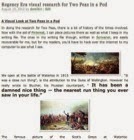 as well at Pinterest and a blog post here.
as well at Pinterest and a blog post here.

February 5, 2015
Regency Personalities Series-Admiral Sir Augustus William James Clifford
Regency Personalities Series
In my attempts to provide us with the details of the Regency, today I continue with one of the��many period notables.
Admiral Sir Augustus William James Clifford
26 May 1788 ��� 8 February 1877
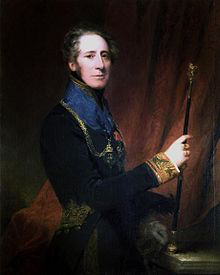
Augustus William James Clifford
Admiral Sir Augustus William James Clifford was born in France in 1788, the illegitimate son of William Cavendish, 5th Duke of Devonshire (and 7th Baron Clifford), and Lady Elizabeth Foster, daughter of Frederick Hervey, 4th Earl of Bristol. Not long after his birth, his mother brought him to England, to be wet-nursed by Louisa Augusta Marshall, wife of the Revd John Marshall, curate at Clewer, near Windsor, Berkshire. Clifford was educated at Harrow School, 1796-99. His parents married in 1809, their respective spouses having died.
He married, on 20 October 1813, Lady Elizabeth Frances Townshend (2 August 1789���10 April 1862 Nice), sister of John Townshend, 4th Marquess Townshend. Each of his sons, Capt William RN, Robert and Charles succeeded their father in turn as the second, third and fourth (and final) baronets.
Clifford was a patron of the arts, and formed a unique collection of paintings, sculpture, etchings, engravings, and bijouterie. He died at his residence in the House of Lords in 1877.
Clifford entered the Royal Navy as a midshipman in May 1800, and was promoted to a lieutenancy in 1806. He served at the reduction of Ste. Lucie and Tobago in 1803, and throughout the operations in Egypt during 1807. He was at the capture of a convoy in the Bay of Rosas in 1809 (for which he received a medal) and in the operations on the coast of Italy 1811���12.
After this, as captain, he was for many years actively employed in naval duties, being several times mentioned in the London Gazette for his courage in cutting-out expeditions and on other occasions. For some time he was engaged in attendance on the Lord High Admiral, the Duke of Clarence, afterwards William IV, and in 1828 he took Lord William Bentinck out to India as governor-general. This was his last service afloat, and he was not actively employed after 1831.
He reached the rank of rear-admiral 23 March 1848, vice-admiral 27 September 1855, Admiral of the Blue 7 November 1860, and Admiral of the Red 1864, becoming retired admiral 31 March 1866.
He was Member of Parliament for Bandon 1818���20; for Dungarvan, 1820���2; and again for Bandon from 23 July 1831 to 3 Dec. 1832. He was nominated a Commander of the Order of the Bath on 8 December 1815, knighted on 4 August 1830, and created a baronet on 4 August 1838. His half-brother, the 6th Duke of Devonshire (then Lord Chamberlain), appointed him on 25 July 1832 Gentleman Usher of the Black Rod, which office he held, much to his satisfaction, until his death. On various occasions between 1843 and 1866 he acted as deputy lord great chamberlain of England, in the absence of Lord Willoughby d’Eresby.

A Trolling we Will Go Omnibus: The first three Fantasy stories of Humphrey and Gwendolyn
A Trolling We Will Go Omnibus:The Early Years Not only do I write Regency and Romance, but I also have delved into Fantasy.
The Trolling series, (the first three are in print) is the story of a man, Humphrey. We meet him as he has left youth and become a man with a man���s responsibilities.
We follow him in a series of stories that encompass the stages of life. We see him when he starts his family, when he has older sons and the father son dynamic is tested.
We see him when his children begin to marry and have children, and at the end of his life when those he has loved, and those who were his friends proceed him over the threshold into death.
All this while he serves a kingdom troubled by monsters. Troubles that he and his friends will learn to deal with and rectify.
Here are the first three books together as one longer novel.
A Trolling We Will Go, Trolling Down to Old Mah Wee and Trolling���s Pass and Present.
Available in a variety of formats.
For $6.99 you can get this fantasy adventure.
Barnes and Noble for your Nook
The stories of Humphrey and Gwendolyn. Published separately in: A Trolling we Will Go, Trolling Down to Old Mah Wee and Trollings Pass and Present.
These are the tales of how a simple Woodcutter and an overly educated girl help save the kingdom without a king from an ancient evil. Long forgotten is the way to fight the Trolls.
Beasts that breed faster than rabbits it seems, and when they decide to migrate to the lands of humans, their seeming invulnerability spell doom for all in the kingdom of Torahn. Not only Torahn but all the human kingdoms that border the great mountains that divide the continent.
Feedback
If you have any commentary, thoughts, ideas about the book (especially if you buy it, read it and like it ;-) then we would love to hear from you.

February 4, 2015
Regency Personalities Series-William Carr Beresford 1st Viscount Beresford
Regency Personalities Series
In my attempts to provide us with the details of the Regency, today I continue with one of the��many period notables.
William Carr Beresford 1st Viscount Beresford
2 October 1768 ��� 8 January 1856
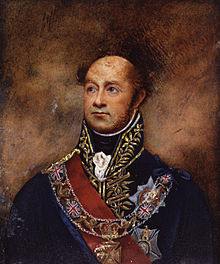
William Carr Beresford
William Carr Beresford 1st Viscount Beresford was the illegitimate son of The 1st Marquess of Waterford. He was the brother of Admiral Sir John Beresford, 1st Baronet (who was also illegitimate), and the half-brother of The 2nd Marquess of Waterford, Archbishop Lord John Beresford and General Lord George Beresford.
Beresford entered the British Army in 1785 as an ensign in the 6th Regiment of Foot and the next year he was blinded in one eye due to an incident with a musket. He remained in the service being promoted to captain by 1791 with the 69th Regiment of Foot. He distinguished himself at Toulon (1793), in Egypt (1799���1803) and in South Africa (1805). From there he fared across the South Atlantic to South America to invade the River Plate region (now Argentina), with a small British force of 1,500 men, departing on 14 April 1806. Following his move to Cape Town in Cape Colony, Beresford, spurred on by Home Popham, R.N. (later Rear Admiral Sir Home Popham), decided to attack Buenos Aires in Spanish South America. No attempt was made to gain authorization from the Crown for this undertaking. In the invasion of the River Plate, Buenos Aires was occupied for 46 days. However, the British force could not maintain itself against the army gathered by Santiago de Liniers. After a relentless two-day fight with the Buenos Aires and Montevideo militias between 10 and 12 August 1806, the British were defeated and forced to capitulate. Beresford had to surrender, remaining prisoner for six months; in the end, he managed to escape and arrived in England in 1807.
In that same year Beresford was sent to Madeira, which he occupied in name of the King of Portugal, remaining there for six months as Governor and Commander in Chief. The exiled Portuguese Government in Rio de Janeiro, Brazil, whereto the Portuguese Royal Family had transferred the Court, realised the necessity of appointing a commander-in-chief capable of training, equipping and disciplining the demoralised Portuguese Army. The Portuguese government asked Britain to appoint Arthur Wellesley to this role, Wellesley indicated he could not do the role justice due to his prior engagements and recommended Beresford. He was appointed Marshal and Commander in Chief of the Army by Decree of 7 March 1809 and took the command on 15th of the same month. At that time, Marshal Soult had already crossed into Portugal where he occupied Porto. Beresford quickly overhauled the Portuguese forces, bringing them in line with British discipline and organization, and from the General Headquarters (then at the Largo do Calhariz), he dispatched many “daily orders” altering points of the Infantry ordnance, creating a general command of Artillery, establishing the separation of the battalions, firing incompetent or corrupt officers and promoting or appointing appropriate replacements.
On 22 April 1809 Sir Arthur Wellesley, later Duke of Wellington, disembarked in Lisbon, and took over the command of all the Anglo-Portuguese troops and he was nominated Marshal General of the Portuguese Army. The allied armies marched to the North. Wellington moved from Coimbra directly to Porto, which he entered on 12 May, and Beresford marched through the Province of Beira, arriving that same day at the banks of the Douro river, in the area of Lamego. Wellington’s troops made a forced crossing of the Douro and defeated the French, Soult was obliged to withdraw from Porto. Soult was outnumbered and was expelled from Portugal; the positioning of Beresford’s forces compelled the French to leave Portugal by the poor roads through Montalegre, they managed to cross the border only after sacrificing their artillery and baggage, and facing numerous difficulties.
The Second French Invasion of Portugal was defeated and the allied armies moved back to the South, the British concentrating at Abrantes and the Portuguese at Castelo Branco. with the intent of cooperating with the Spanish against Marshal Victor, the Anglo-Portuguese forces under Wellesley moved into Spain in the Talavera campaign while Beresford remained on the ��gueda River covering the Spanish-Portuguese border. After Wellesley’s return, now as Viscount Wellington, following the Battle of Talavera Beresford re-entered Portugal, where he distributed the army at various locations established his General Headquarters in Lisbon. From Lisbon he dispatched numerous orders and instructions for the reform of the Portuguese military.
In the same year (1809), and the following year he made tours of inspection of the corps that were found quartered in the various provinces and he corrected any defects he noticed and established rules for the functioning of the different branches of the military service. In this way he improved the functioning of the Portuguese Army so that they might face the forces of Napoleon that were invading the country for the third time. The good results of his efforts were proven at the campaign against Mass��na in particular at the Battle of Bu��aco, 27 September 1810 where the Portuguese troops played a prominent part, and also in the defence of the Lines of Torres Vedras).
The most notable action in which Beresford held independent command occurred in 1811 when a combined Anglo-Portuguese and Spanish army under his command, intercepted a French army commanded by Marshal Soult who had been ordered by Marshal Auguste Marmont to move to protect the important Spanish fortress-city of Badajoz. As the French forces retreated from the Lines of Torres Vedras, Beresford marched towards Badajoz, which he laid siege to. Having, however, received notice that Soult was approaching, he lifted the siege and posted his army at Albuera in a defensive position. There he defeated the French forces on 16 May 1811. After the very bloody Battle of Albuera the French were forced to retreat, though the siege of Badajoz had to be subsequently abandoned. Meanwhile, on 13 May 1811, he was created Count of Trancoso in Portugal by decree of Prince Regent John.
At the beginning of July 1811 he was again in Lisbon, but he was subjected to fits of “nervous breakdowns”, as described by brigadier D’Urban, quarter master general of the Portuguese Army. He recuperated in February 1812 and he then joined Wellington in his investment of Ciudad Rodrigo. He accompanied, after this fortified town had fallen, the army to Alentejo, and participated in the Anglo-Portuguese Siege of Badajoz. After Badajoz had been stormed the two Generals, Wellington and Beresford, again took up position on the ��gueda, and from there launched the Salamanca campaign. On 22 July 1812, the important Battle of Salamanca was fought, giving the Anglo-Portuguese forces a decisive victory over the French under Marshal Marmont. In the battle Beresford was badly wounded, under his left breast, when he was ordering the advance of one of the Portuguese brigades.
He retired to Lisbon and had bouts of fever and was half incapacitated for several months until May of the next year (1813). Meanwhile he was also created Marquis of Campo Maior in Portugal by Prince Regent John on 17 December 1812. In March he was confirmed as second in command of the Allied Army and rejoined the campaigning army, and assisted in the liberation of Spain by the British and Portuguese armies.
In the invasion of France, he assisted Wellington at the command of a corps and he was hailed as the liberator of Bordeaux. He fought in France at Toulouse the last clash of the Peninsular War.
After peace was declared he went to England on leave and came back again to Lisbon to reassume the command of the Portuguese Army. He did not limit himself, however, to that role, and intended to intervene in the general politics of the country, from this he came into conflict with the Regency. He then determined to go to the Court in Rio de Janeiro. He departed to there in August 1815 and returned in September 1816, invested with wider powers than the ones which he had previously enjoyed. Beresford took a high hand in his dealings with Gomes Freire de Andrade (1817) and, put into a difficult situation, he returned to Brazil, obtaining from John VI the confirmation of the powers he had already attained, which he desired to see amplified.
When he returned to Portugal, the Liberal Revolution of 1820 intervened; the British officers, for the most part, had been discharged, and the government would not even consent that Beresford could disembark. He was made Governor of Jersey in 1821 and held the position till 1854. Briefly returning to Portugal in 1827 at request of the Regent, Infanta Isabel Maria of Braganza, he gave up his ambitions due to the resistance he found among the new Portuguese elite and returned to Britain.
In the 1840s, Beresford expanded the Bedgebury Estate near Goudhurst, Kent. He built the hamlet of Kilndown to the north west of Bedgebury.
Napier, in his History of the Peninsular War, severely criticized the tactics of Beresford at the Battle of Albuera, which gave origin to a heated correspondence between the Marshal and the historian. The published letters of Beresford which are mentioned below refer to this controversy. Wellington himself had no illusions over Beresford’s ability as a General, but he appreciated his abilities as a military organizer that he recommended, in case of his death, that Beresford succeeded him in command. He published: Strictures on Certain Passages of L. Col. Napier’s History of Peninsular War; Further Strictures; Refutation of Col. Napier’s Justification, London, 1831���1834, 3 Vol.; Letter to Charles Edward Long, Esq. on the Extracts Recently Published from the Ms. Journal and Private Correspondence of the Late Lieut-Gen. R. B. Long, London, John Murray, 1833; A Second Letter to Charles Edward Long, Esq. on the Ms. Journal and Private Correspondence of the Late Lieut. General R. B. Long (1834). Also of interest is the Colec����o das Ordens do Dia (Collection of Orders of the Day) produced by Beresford’s general headquarters nos Anos de 1809 a 1823 (for the years 1809 to 1823), Lisbon, 13 Vol. (at the Library of the English Institute of the University of Coimbra).
As a reward for his services in the fight against the French he was raised to the peerage as Baron Beresford, of Albuera and Dungarvan in the County of Waterford, in 1814. In 1823 he was further honoured when he was made Viscount Beresford, of Beresford in the County of Stafford, in 1823. He was the last titular Governor of Jersey; since his death the Crown has been represented in Jersey by the Lieutenant Governor of Jersey. Beside many national and foreign decorations he had the Grand Cross of the Portuguese Order of the Tower and Sword. Some authors infer that he also had the title of 1st Duke of Elvas; but no document recording the granting this title is extant. Beresford County, New South Wales, Australia was named in his honour.
Beresford was Member of Parliament (MP) for County Waterford from 1811 to 1814.
He was sworn of the Privy Council in 1821.
Lord Beresford married his first cousin the Honourable Louisa, widow of Thomas Hope and daughter of William Beresford, 1st Baron Decies and Elizabeth Fitzgibbon, in 1832. The marriage was childless. She died in July 1851. Lord Beresford died in January 1854, aged 85. The barony and viscountcy became extinct on his death. His estates were passed on to his stepson, Alexander Beresford Hope. Beresford’s Portuguese titles were not renewed, although his nephews continued using them.

A Jane Austen Sequel: Colonel Fitzwilliam’s Correspondence
Colonel Fitzwilliam���s Correspondence For your enjoyment, one of the Regency Romances I published.
It is available for sale and I hope that you will take the opportunity to order your copy.
For yourself or as a gift. It is now available in a variety of formats.
For just a few dollars this Regency Romance can be yours for your eReaders or physically in Trade Paperback.
Visit the dedicated Website
Barnes and Noble for your Nook or in Paperback
Amazon for your Kindle or in Trade Paperback
Witnessing his cousin marry for love and not money, as he felt destined to do, Colonel Fitzwilliam refused to himself to be jealous. He did not expect his acquaintance with the Bennet Clan to change that. ������
Catherine Bennet, often called Kitty, had not given a great deal of thought to how her life might change with her sisters Elizabeth and Jane becoming wed to rich and connected men. Certainly meeting Darcy���s handsome cousin, a Colonel, did not affect her. ����
��But one had to admit that the connections of the Bingleys and Darcys were quite advantageous. All sorts of men desired introductions now that she had such wealthy new brothers. ������
Kitty knew that Lydia may have thought herself fortunate when she had married Wickham, the first Bennet daughter to wed. Kitty, though, knew that true fortune had come to her. She just wasn���t sure how best to apply herself.
Feedback
If you have any commentary, thoughts, ideas about the book (especially if you buy it, read it and like it ;-) then we would love to hear from you.

February 3, 2015
Regency Personalities Series-John Stockdale
Regency Personalities Series
In my attempts to provide us with the details of the Regency, today I continue with one of the��many period notables.
John Stockdale
25 March 1750 ��� 21 June 1814
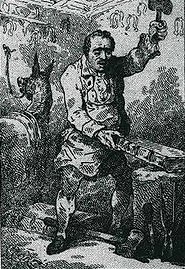
John Stockdale
John Stockdale was born in Caldbeck, Cumberland, the son of Priscilla Stockdale (1726���1789) and, Joseph Stockdale. He is believed to have been raised as a blacksmith, like his father, and then to have become valet to John Astley of Dukinfield, Cheshire. He married Mary Ridgway, a native of Roe Cross, Mottram-in-Longdendale, Cheshire, and sister to James Ridgway, a well-known publisher of Piccadilly, London. He had met Mary in the Dukinfield Moravian chapel.
Stockdale moved to London about 1780 and worked as a porter to publisher John Almon, near to the premises of his brother in law. When Almon retired from business in favour of John Debrett, Stockdale opened a book shop in competition and, “being a man of natural parts, he soon became conspicuous in business in spite of much eccentricity of conduct and great coarseness of manners”. Both Stockdale’s and Debrett’s premises became meeting places for the political classes, Debrett’s being frequented by the Whigs and Stockdale’s by the supporters of William Pitt. John Adams, one of the Founding Fathers of the United States (the 2nd President of the United States) lodged with Stockdale for two months during 1783.
He was an industrious publisher and among the many works that he published were:
Adam Ferguson’s History of the Progress and Termination of the Roman Republic (1783);
An edition of William Shakespeare’s Dramatic Works (1784);
Bryan Edwards’s History of the West Indies;
George Chalmers’ edition of Daniel Defoe’s History of the Union;
Arthur Phillip’s Voyage to Botany Bay;
Samuel Johnson’s Works (1787) (volumes 12 and 13 of which Stockdale edited);
John Whitaker various works.
Hester Thrale’s Retrospection: or, a review of the most striking and important events, characters, situations and their consequences, which the last eighteen hundred years have presented to the view of mankind (1801).
He also issued the London Courant newspaper, Debates in Parliament (1784���90), an edition of Robinson Crusoe and John Aikin’s A Description of the Country from Thirty to Forty Miles round Manchester (1795), originally intended to be merely an account of the neighbourhood of Mottram-in-Longdendale, with which Stockdale had personal acquaintance.
In 1788 he published John Logan’s Review of the Charges against Warren Hastings. The work was conceived by the government to embody a libellous charge of corruption and injustice against the House of Commons. Stockdale was accordingly prosecuted. The case came before Lord Kenyon in December 1789 and Stockdale was eloquently defended by Thomas Erskine. Erskine contended that the defendant was not to be judged by isolated passages, selected and put together in the accusation, but by the entire context of the publication and its general character and objects. Stockdale was acquitted, and such a conspicuous defence of the liberty of the press led to the passing of the Libel Act 1792, which established that nobody was to be punished for a few unguarded expressions, and left the construction of an alleged libeller’s general purpose and animus in writing to a jury.
Stockdale again figured as defendant in an action for libel brought by Joseph Nightingale in 1809, when he had to pay ��200 damages. Towards the end of his career he dealt largely in remaindered books from other publishers, and caused some resentment among the regular traders by a series of sales of books by auction which he established in various parts of the country. Early in his enterprise he had acquired considerable property, but afterwards he was less successful and the circumstance of having to make an arrangement with his creditors is said to have caused him some anxiety and accelerated his death.
Stockdale and his wife had several children including:
Mary Stockdale, writer and publisher;
John Joseph Stockdale, publisher who was also the subject of a libel case involving parliament in Stockdale v. Hansard; and
William Stockdale, bookseller.

An Unofficial Guide to how to win the Scenarios of Rollercoaster Tycoon 3 Soaked and Wild
An Unofficial Guide to how to win the Scenarios of Rollercoaster Tycoon 3, Soaked! and WILD!
I have been a fan of this series of computer games since early in its release of the very first game. That game was done by one programmer, Chris Sawyer, and it was the first I recall of an internet hit. Websites were put up in dedication to this game where people showed off their creations, based on real amusement parks. These sites were funded by individuals, an expense that was not necessarily as cheap then as it is now. Nor as easy to program then as it might be to build a web page now.
Prima Books released game guides for each iteration of the game, Rollercoaster Tycoon 1, Rollercoaster Tycoon 2 and Rollercoaster Tycoon 3 (RCT3) but not for the expansion sets. And unlike the first two works, the third guide was riddled with incorrect solutions. As I played the game that frustrated me. And I took to the forums that Atari, the game publisher hosted to see if I could find a way to solve those scenarios that the Prima Guide had written up in error. Not finding any good advice, I created my own for the scenarios that the ���Official��� Guide had gotten wrong.
Solutions that if you followed my advice you would win the scenario and move on. But if you followed the
���Official��� version you would fail and not be able to complete the game. My style and format being different than the folks at Prima, I continued for all the Scenarios that they had gotten right as well, though my solutions cut to the chase and got you to the winner���s circle more quickly, more directly.
My contributions to the ���Official��� Forum, got me a place as a playtester for both expansions to the game, Soaked and Wild. And for each of these games, I wrote the guides during the play testing phase so all the play testers could solve the scenarios, and then once again after the official release to make changes in the formula in case our aiding to perfect the game had changed matters. For this, Atari and Frontier (the actual programmers of the game) placed me within the game itself.
And for the longest time, these have been free at the ���Official��� Forums, as well as my own website dedicated to the game. But a short time ago, I noticed that Atari, after one of its bankruptcies had deleted their forums. So now I am releasing the Guide for one and all. I have added new material and it is over 150 pages, for all three games. It is available for the Kindle at present for $7.99. It is also available as a trade paperback for just a little bit more.
You can also find this at Smashwords, iBooks, Kobo and Barnes and Noble
(Click on the picture to purchase)
Not only are all 18 Scenarios covered, but there are sections covering every Cheat Code, Custom Scenery, the famous Small Park Competition, the Advanced Fireworks Editor, the Flying Camera Route Editor which are all the techniques every amusement park designer needs to make a fantastic park in Rollercoaster Tycoon 3.
Scenarios for RCT 3
1) Vanilla Hills
2) Goldrush
3) Checkered Flag
4) Box Office
5) Fright Night
6) Go With The Flow
7) Broom Lake
8) Valley of Kings
9) Gunslinger
10) Ghost Town
11) National Treasure
12) New Blood
13) Island Hopping
14) Cosmic Crags
15) La La Land
16) Mountain Rescue
17) The Money Pit
18) Paradise Island
Scenarios for Soaked!
1) Captain Blackheart’s Cove
2) Oasis of Fun
3) Lost Atlantis
4) Monster Lake
5) Fountain of Youth
6) World of the Sea
7) Treasure Island
8) Mountain Spring
9) Castaway Getaway
Scenarios for WILD!
1) Scrub Gardens
2) Ostrich Farms Plains
3) Egyptian Sand Dance
4) A Rollercoaster Odyssey
5) Zoo Rescue
6) Mine Mountain
7) Insect World
8) Rocky Coasters
9) Lost Land of the Dinosaurs
10) Tiger Forest
11) Raiders of the Lost Coaster
12) Saxon Farms

February 2, 2015
Regency Personalities Series-Jane Taylor
Regency Personalities Series
In my attempts to provide us with the details of the Regency, today I continue with one of the��many period notables.
Jane Taylor
23 September 1783 ��� 13 April 1824
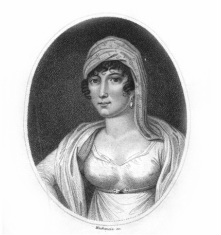
Jane Taylor
Jane Taylor lived with her family at Shilling Grange in Shilling Street, Lavenham, Suffolk,her house can still be seen. Later (1796���1810) she lived in Colchester ��� it is a majority belief between local historians, that the rhyme was written in Colchester ��� although Ongar still makes a claim, both in Essex. The Taylor sisters were part of an extensive literary family. Their father, Isaac Taylor of Ongar, was an engraver and later a dissenting minister. Their mother, Ann Taylor (n��e Martin) (1757���1830), wrote seven works of moral and religious advice, two of them fictionalised.
The poem, Original Poems for Infant Minds by several young persons (i.e. Ann and Jane Taylor and others) was first issued in two volumes in 1804 and 1805. Rhymes for the Nursery followed in 1806, and Hymns for Infant Minds in 1808. In Original Poems for Infant Minds (1805) primarily written by Ann and Jane Taylor and Adelaide O’Keeffe, the authors were identified for each poem, but they were not for Rhymes for the Nursery (1806). The most famous piece in these was “The Star” more commonly known today as “Twinkle, Twinkle Little Star”, which was set to a French tune.
Christina Duff Stewart identifies authorship in Rhymes for the Nursery based on a copy belonging to Canon Isaac Taylor, who noted the pieces by Ann and Jane Taylor. Canon Isaac was Taylor’s nephew, a son of her brother Isaac Taylor of Stanford Rivers. Stewart also confirms attributions of Original Poems based on the publisher’s records.
Taylor’s novel Display (1814), reminiscent of Maria Edgeworth or perhaps even Jane Austen, went through at least nine editions up to 1820. Her Essays in Rhyme appeared in 1816, and contained some significant poetry. In the fictional Correspondence between a Mother and Her Daughter at School (1817) Taylor collaborated with her mother. The Family Mansion. A Tale appeared in 1819, and Practical Hints to Young Females previous to 1822. Throughout her life, Taylor wrote many essays, plays, stories, poems, and letters which were never published.
Jane Taylor died of breast cancer at the age of 40, her mind still “teeming with unfulfilled projects”. She was buried in Ongar churchyard.
After her death, her brother Isaac collected many of her works and included a biography of her in The Writings of Jane Taylor, In Five Volumes (1832).


